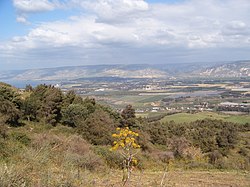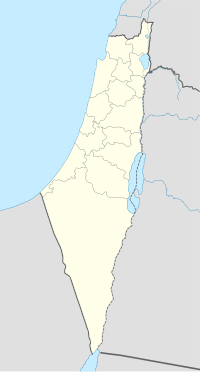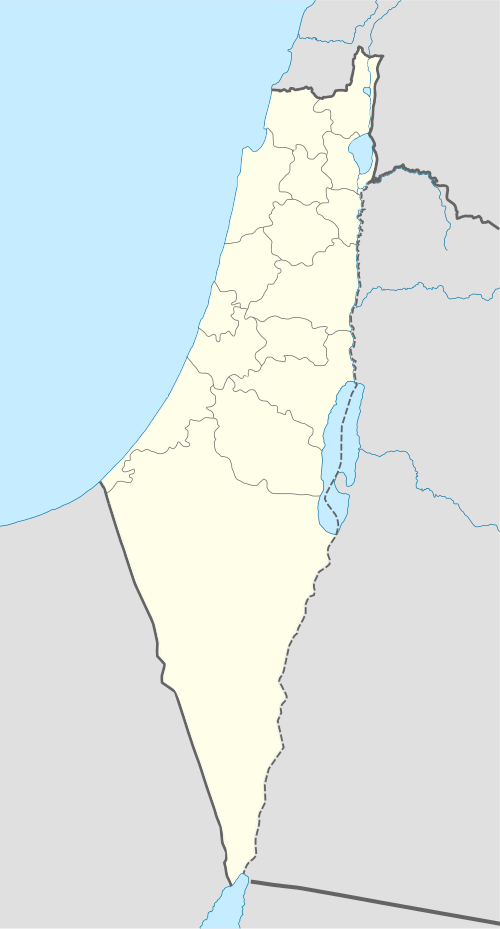Al-Ja'una: Difference between revisions
slight expansion (with Robinson, 1838 info), declutter, ce |
Zackmann08 (talk | contribs) |
||
| Line 1: | Line 1: | ||
{{Infobox |
{{Infobox settlement |
||
|name=Al-Ja'una |
| name = Al-Ja'una |
||
| ⚫ | |||
| ⚫ | |||
| native_name_lang = ar |
|||
|imgsize=250 |
|||
| ⚫ | |||
| ⚫ | |||
| settlement_type = Village |
|||
| ⚫ | |||
<!-- images, nickname, motto --> |
|||
| ⚫ | |||
| ⚫ | |||
| ⚫ | |||
| imagesize = 250 |
|||
|district=sf |
|||
| ⚫ | |||
| ⚫ | |||
| ⚫ | |||
|palgrid=200/264 |
|||
<!-- maps and coordinates --> |
|||
| ⚫ | | |
||
| pushpin_map = Mandatory Palestine |
|||
|popyear=1945 |
|||
| pushpin_mapsize = 200 |
|||
| ⚫ | |||
| ⚫ | |||
|areakm= |
|||
| grid_name = [[Palestine grid|Palestine grid]] |
|||
|cause=C |
|||
| grid_position = 200/264 |
|||
|cause2= |
|||
<!-- location --> |
|||
|curlocl=[[Rosh Pinna]] |
|||
| subdivision_type = [[Geopolitical entity]] |
|||
| ⚫ | |||
| |
| subdivision_name = [[Mandatory Palestine]] |
||
| subdivision_type1 = [[Districts of Mandatory Palestine|Subdistrict]] |
|||
| subdivision_name1 = [[Safad Subdistrict, Mandatory Palestine|Safad]] |
|||
<!-- established --> |
|||
| established_title1 = Date of depopulation |
|||
| ⚫ | |||
| established_title2 = Repopulated dates |
|||
<!-- area --> |
|||
| unit_pref = dunam |
|||
| ⚫ | |||
<!-- population --> |
|||
| population_as_of = 1945 |
|||
| ⚫ | | population_total = 1,150<ref name=1945p9>Department of Statistics, 1945, p. [http://cs.anu.edu.au/~bdm/yabber/census/VSpages/VS1945_p09.jpg 9]</ref><ref name=Hadawi70>Government of Palestine, Department of Statistics. ''Village Statistics, April, 1945.'' Quoted in Hadawi, 1970, p. [http://www.palestineremembered.com/download/VillageStatistics/Table%20I/Safad/Page-070.jpg 70]</ref> |
||
<!-- blank fields (section 1) --> |
|||
| blank_name_sec1 = Cause(s) of depopulation |
|||
| blank_info_sec1 = Influence of nearby town's fall |
|||
| blank3_name_sec1 = Current Localities |
|||
| blank3_info_sec1 = [[Rosh Pinna]] |
|||
}} |
}} |
||
'''Al-Ja'una''' or Ja'ouna (Arabic: الجاعونة), was a Palestinian village situated in [[Galilee]] near [[al-Houleh Plateau]], overlooking the [[Jordan Valley (Middle East)|Jordan Valley]]. The village lay on a hillside 450–500 meters above sea level, 5 kilometers east of [[Safad]] near a major road connecting Safad with [[Tabariya]]. The Israeli town of [[Rosh Pinna]] (Hebrew:ראש פינה) sits on the former village site, which was expanded to include the depopulated Palestinian Al-Ja'una.{{citation needed|date=December 2015}} |
'''Al-Ja'una''' or Ja'ouna (Arabic: الجاعونة), was a Palestinian village situated in [[Galilee]] near [[al-Houleh Plateau]], overlooking the [[Jordan Valley (Middle East)|Jordan Valley]]. The village lay on a hillside 450–500 meters above sea level, 5 kilometers east of [[Safad]] near a major road connecting Safad with [[Tabariya]]. The Israeli town of [[Rosh Pinna]] (Hebrew:ראש פינה) sits on the former village site, which was expanded to include the depopulated Palestinian Al-Ja'una.{{citation needed|date=December 2015}} |
||
Revision as of 22:20, 21 March 2019
Al-Ja'una
الجاعونة Jaauneh[1] | |
|---|---|
Village | |
 The village overlooked the Jordan Valley | |
| Etymology: from personal name[2] | |
| Coordinates: 32°58′18″N 35°31′58″E / 32.97167°N 35.53278°E | |
| Palestine grid | 200/264 |
| Geopolitical entity | Mandatory Palestine |
| Subdistrict | Safad |
| Date of depopulation | 9 May 1948[5] |
| Area | |
| • Total | 839[4] dunams (Expression error: Unrecognized punctuation character "". ha or Expression error: Unrecognized punctuation character "". acres) |
| Population (1945) | |
| • Total | 1,150[3][4] |
| Cause(s) of depopulation | Influence of nearby town's fall |
| Current Localities | Rosh Pinna |
Al-Ja'una or Ja'ouna (Arabic: الجاعونة), was a Palestinian village situated in Galilee near al-Houleh Plateau, overlooking the Jordan Valley. The village lay on a hillside 450–500 meters above sea level, 5 kilometers east of Safad near a major road connecting Safad with Tabariya. The Israeli town of Rosh Pinna (Hebrew:ראש פינה) sits on the former village site, which was expanded to include the depopulated Palestinian Al-Ja'una.[citation needed]
History
Broken pillars and a capital has been found here.[6]
Ottoman era
Al-Ja'una was mentioned in the 1596 Ottoman census as being a village in the nahiya (subdistrict) of Jira, in the Safad Sanjak, with 27 households and 4 bachelors, an estimated population of 171. All the villagers were Muslim. The villagers paid a fixed tax rate of 25% on various agricultural products, such as wheat, barley, olives, goats, beehives, and a powered mill; a total of 2,832 akçe. 1/12 of the revenue went to a Muslim charitable institution.[7][8][9]
The village appeared under the name of Gahoun on the map that Pierre Jacotin compiled during Napoleon's invasion of 1799.[10]
In 1838, it was noted as el-Ja'uneh, a Muslim village, located in the el-Khait district.[11]
In 1875, Victor Guérin found that Al-Ja'una had 200 Muslim inhabitants.[12]

In 1881 the Palestine Exploration Fund's Survey of Western Palestine described the village as being built of stone, on the slope of a hill, whose 140-200 residents cultivated fig and olive trees.[1][13] There were two springs in a wadi, south of the village.[1] A mosque and an elementary school for boys was established in the village in Ottoman times.[13]
The settlement of Rosh Pinna is located to the southeast of the village site. It was first established in 1878 on land purchased from the villagers of al-Ja'una but has expanded over the years to now include part of the former village land of Al-Ja'una.[13]
Laurence Oliphant visited Rosh Pinna and Al-Ja'una in 1886, and wrote:
"Jauna, which was the name of the village to which I was bound, was situated about three miles (5 km) from Safad, in a gorge, from which, as we descended it, a magnificent view was obtained over the Jordan valley, with the Lake of Tiberias lying three thousand feet below us on the right, and the waters of Merom, or the Lake of Huleh, on the left. The intervening plain was a rich expanse of country, only waiting development. The new colony had been established about eight months, the land having been purchased from the Moslem villagers, of whom twenty families remained, who lived on terms of perfect amity with the Jews."[14]
A population list from about 1887 showed Ja’auneh to have about 930 inhabitants; 555 Muslims and 375 Druze.[15]
British Mandate era
In the 1922 census of Palestine, conducted by the British Mandate authorities, Ja'uneh had a population of 626; all Muslims,[16] increasing in the 1931 census to 799, still all Muslims, in a total of 149 houses.[17]
Felix Salten visited Rosh Pinna in 1924 and noted also Al-Ja’una in his travel book Neue Menschen auf alter Erde:
“Right next to Rosh Pin[n]a, the Arab village Dzha’une. These early settlers still employ Arab workers, a practice that naturally had to cease within the new rebuilding movement. The Arabian children of Dzha’une all go to school that has been built for them by the settlement [of Rosh Pinna] and they are taught Hebrew there.”[18]
In the 1945 statistics the population was 1,150 Muslims,[3] and the total land area was 839 dunums; 824 of which were owned by Arabs, 7 by Jews, and 8 public.[4] Of this, 172 dunums were plantations and irrigable land, 248 used for cereals,[19] while 43 dunams were built-up (urban) land.[20]
1948 Arab-Israeli war, depopulation, and aftermath
The village was depopulated during the 1948 Arab–Israeli War. According to Israeli historian Benny Morris, the evacuation of the residents of al-Ja'una occurred some time before 2 May 1948, although he has somewhat contradicted this by also documenting that the actual depopulation took place one week later, on 9 May, coinciding with the final attack on Safad.[21]
At midnight on 5–6 June 1949, the remaining villagers in Al-Ja'una (together with those of Al-Khisas and Qaytiyya) were surrounded by Israeli Defence Force units, who then forced the villagers into trucks "with brutality—with kicks, curses and maltreatment...." (in the words of Knesset member and Al HaMishmar editor Eliezer Peri) and dumped them on a bare hillside near the village of 'Akbara.[22] When questioned about the expulsions, David Ben-Gurion responded that he found the military reasons for the evictions "sufficient".[23] 'Akbara served as a "dumping spot" for the "remainders" from various depopulated Palestinian villages, and its conditions were to remain bad for years.[24]
Walid Khalidi, writing in 1992 about the remains of Al-Ja'una, stated: "The settlement of Rosh Pinna occupies the village site. Many of the houses remain; some are used by the residents of the settlement; other stone houses have been abandoned and destroyed."[21]
See also
- 1948 Palestinian exodus
- List of villages depopulated during the Arab–Israeli conflict
- Abdallah Al-Asbah
References
- ^ a b c Conder and Kitchener, 1881, SWP 1, p.198
- ^ Palmer, 1881, p. 72
- ^ a b Department of Statistics, 1945, p. 9
- ^ a b c Government of Palestine, Department of Statistics. Village Statistics, April, 1945. Quoted in Hadawi, 1970, p. 70
- ^ According to Morris, 2004, p. xvi, village #52. Also gives the cause of depopulation
- ^ Conder and Kitchener, 1881, SWP I, p. 224
- ^ Hütteroth and Abdulfattah, 1977, p. 177. Quoted in Khalidi, 1992, p. 458
- ^ Note that Rhode, 1979, p. 6 writes that the register that Hütteroth and Abdulfattah studied was not from 1595/6, but from 1548/9
- ^ Hütteroth and Abdulfattah, 1977, p. 177
- ^ Karmon, 1960, p. 165
- ^ Robinson and Smith, vol 3, 2nd appendix, p. 136
- ^ Guérin, 1880, p. 454
- ^ a b c Khalidi, 1992, p. 458
- ^ Oliphant, 1887, p.71
- ^ Schumacher, 1888, p. 189
- ^ Barron, 1923, Table XI, Sub-district of Safad, p. 41
- ^ Mills, 1932, p. 107
- ^ Salten, Felix (1925). Neue Menschen auf alter Erde: Eine Palästinafahrt (in German). Wien: Paul Zsolnay Verlag. p. 222. LCCN 25023844.
- ^ Government of Palestine, Department of Statistics. Village Statistics, April, 1945. Quoted in Hadawi, 1970, p. 119
- ^ Government of Palestine, Department of Statistics. Village Statistics, April, 1945. Quoted in Hadawi, 1970, p. 169
- ^ a b Khalidi, 1992, p. 459
- ^ Morris, 2004, p. 511-512
- ^ Morris, 2004, p. 512, note 51
- ^ Morris, 2004, p. 513, note 54
Bibliography
- Barron, J. B., ed. (1923). Palestine: Report and General Abstracts of the Census of 1922. Government of Palestine.
- Conder, C.R.; Kitchener, H. H. (1881). The Survey of Western Palestine: Memoirs of the Topography, Orography, Hydrography, and Archaeology. Vol. 1. London: Committee of the Palestine Exploration Fund.
- Department of Statistics (1945). Village Statistics, April, 1945. Government of Palestine.
- Guérin, V. (1880). Description Géographique Historique et Archéologique de la Palestine (in French). Vol. 3: Galilee, pt. 2. Paris: L'Imprimerie Nationale.
- Hadawi, S. (1970). Village Statistics of 1945: A Classification of Land and Area ownership in Palestine. Palestine Liberation Organization Research Center.
- Hütteroth, Wolf-Dieter; Abdulfattah, Kamal (1977). Historical Geography of Palestine, Transjordan and Southern Syria in the Late 16th Century. Erlanger Geographische Arbeiten, Sonderband 5. Erlangen, Germany: Vorstand der Fränkischen Geographischen Gesellschaft. ISBN 3-920405-41-2.
- Karmon, Y. (1960). "An Analysis of Jacotin's Map of Palestine" (PDF). Israel Exploration Journal. 10 (3, 4): 155–173, 244–253.
- Khalidi, W. (1992). All That Remains:The Palestinian Villages Occupied and Depopulated by Israel in 1948. Washington D.C.: Institute for Palestine Studies. ISBN 0-88728-224-5.
- Mills, E., ed. (1932). Census of Palestine 1931. Population of Villages, Towns and Administrative Areas. Jerusalem: Government of Palestine.
- Morris, B. (2004). The Birth of the Palestinian Refugee Problem Revisited. Cambridge University Press. ISBN 978-0-521-00967-6.
- Oliphant, L. (1887). Haifa, or Life in Modern Palestine. archive.org.
- Palmer, E. H. (1881). The Survey of Western Palestine: Arabic and English Name Lists Collected During the Survey by Lieutenants Conder and Kitchener, R. E. Transliterated and Explained by E.H. Palmer. Committee of the Palestine Exploration Fund. (p. 71)
- Rhode, H. (1979). Administration and Population of the Sancak of Safed in the Sixteenth Century. Columbia University.
- Robinson, E.; Smith, E. (1841). Biblical Researches in Palestine, Mount Sinai and Arabia Petraea: A Journal of Travels in the year 1838. Vol. 3. Boston: Crocker & Brewster.
- Schumacher, G. (1888). "Population list of the Liwa of Akka". Quarterly statement - Palestine Exploration Fund. 20: 169–191.
External links
- Welcome To al-Ja'una, Palestine Remembered
- Al-Ja'una, Zochrot
- Survey of Western Palestine, Map 4: IAA, Wikimedia commons
- al-Ja'una, from the Khalil Sakakini Cultural Center
- Al-Ja`una, Dr. Khalil Rizk.
- Al-Ja3ooneh, from Dr. Moslih Kanaaneh
- UN map of the 1947 plan
- The Destroyed Palestinian Villages on Google Earth
- Tracing all That Remains of al-Ja'una-جاعونة المدمرة-فلسطين, video, YouTube

